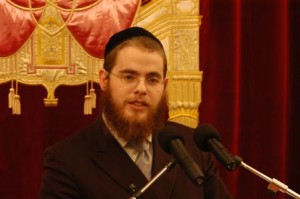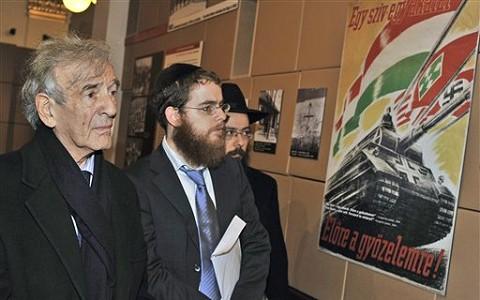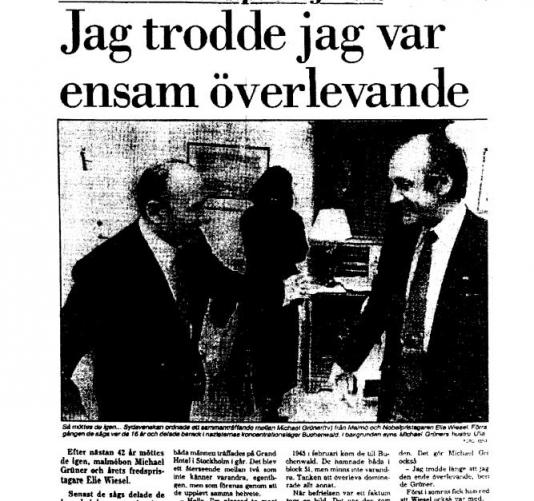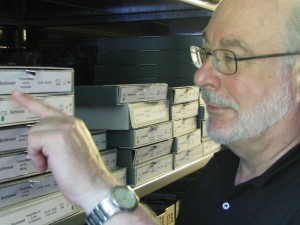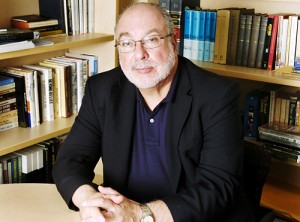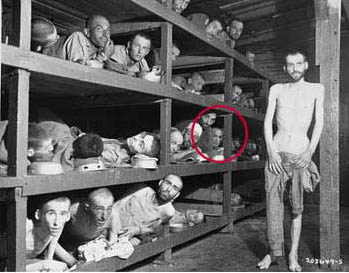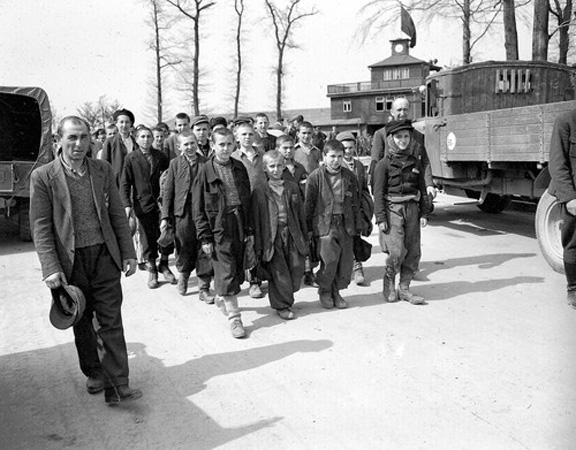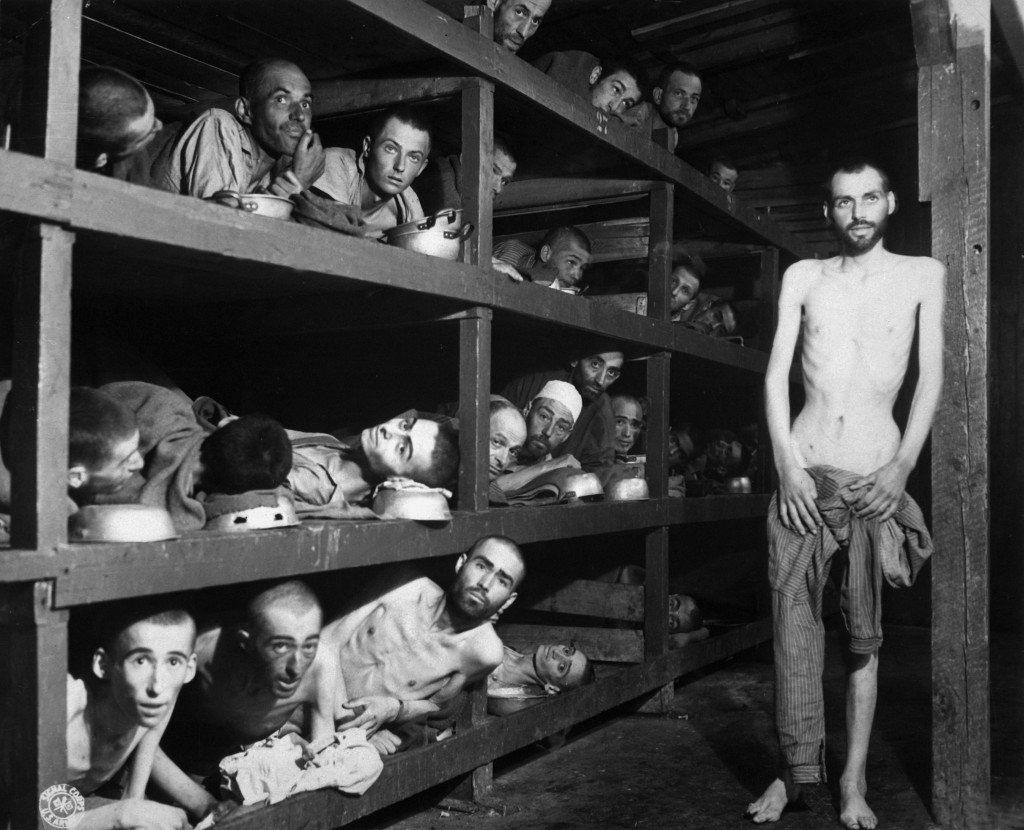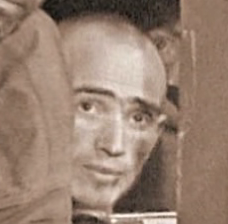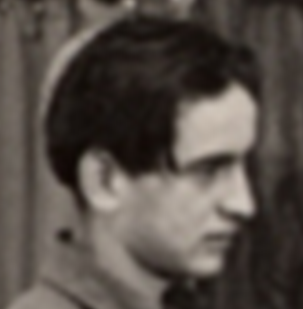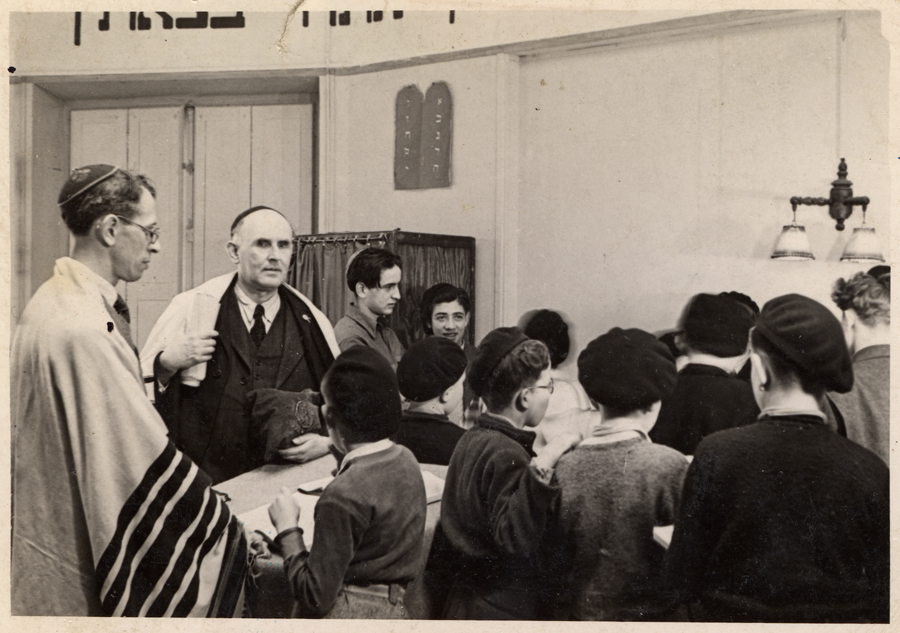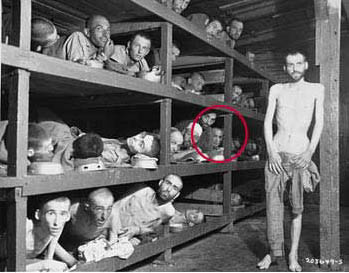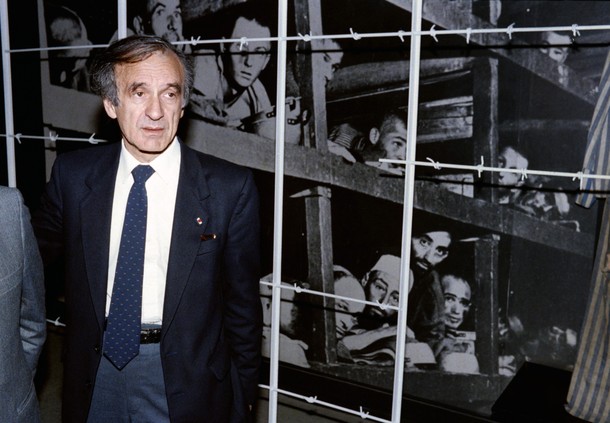Photos and Video: How the Jew Elie Wiesel conned the world! – The Holocaust!
[There’s a lot of good, detailed stuff in here by Carolyn Yeager about this lying Jew and all his holocaust garbage. Jan]
Grüner Lawsuit Against Rabbi Rejected by Budapest Court
by Carolyn Yeager
As expected, a judge in a Budapest court has rejected a lawsuit brought by Hungarian-born Nikolaus (Miklós) Grüner against Chabad rabbi Slomo Köves for helping to arrange Elie Wiesel’s “Homecoming Tour” to Hungary in 2009. Grüner maintains that Elie Wiesel is not Hungarian and not a holocaust survivor.
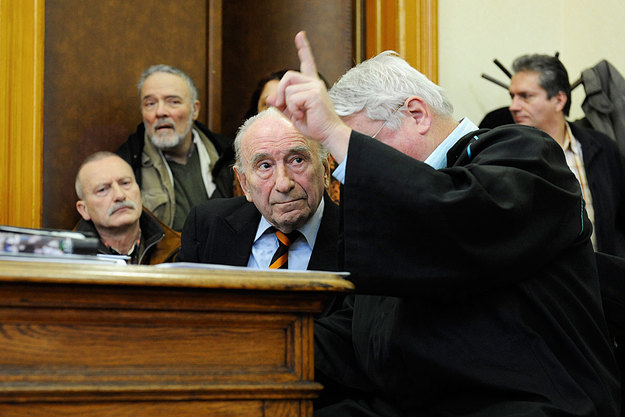 Nikolaus Grüner, center facing camera, watches as a barrister makes a point in court during his January 27th hearing.
Nikolaus Grüner, center facing camera, watches as a barrister makes a point in court during his January 27th hearing.
The lawsuit was brought against Köves, described as the rabbi of the Chabad community in Budapest, (pictured right) rather than Wiesel because of the lack of jurisdiction over an American citizen by a Hungarian court. Grüner’s personal dispute with Köves now seem to have taken precedence; he is complaining that “The rabbi basically called me a liar in his statement.”
According to Bos-News Life Christian news service, Gruner said he was angered by the court’s statement Monday, February 6 that it wasn’t able to rule on whether Wiesel had lied about his Holocaust past because he lives in America. “I never wanted the Hungarian court to rule on that issue. However I wanted the court to give an opinion about the unjustified statements made by the rabbi.”
The rabbi had called the 83-year-old Grüner “an elderly man with some kind of complex” and accused him of “falsifying history” by claiming Wiesel is not survivor of Auschwitz and Buchenwald. Köves also publicly likened Grüner to American author Norman Finkelstein, who wrote The Holocaust Industry. Finklestein is considered something of a “holocaust denier” by Jews even though he is simply critical of the way it has been marketed for immense profits to Israel.
Grüner says that these kind of remarks from Köves could undermine his plans to directly sue Wiesel in the United States; he wanted the court to rule against Köves for making these remarks. He told Bos-News Life that he would “appeal the ruling and court procedure and demand a new trial” later this month. The news service also reported that Grüner plans to travel to the United States this month to demand that American authorities extradite Wiesel to Hungary and to meet a lawyer representing Holocaust survivors.
This last appears to Elie Wiesel Cons the World to be a ‘mission impossible.’ However, we applaud Mr. Grüner for doing his best to keep the Elie Wiesel hoax issue alive in the public mind and wish him well.
Nikolaus Grüner shows his tattoo. Where’s Elie’s?
By Carolyn Yeager
In this video, Nikolaus or Miklos (Michael) Grüner is being interviewed by the Modesto (Calif.) Bee while the photographer films him pointing out the tattoo on his left arm. This is shown in the very beginning of the video; right after that we see the famous “Buchenwald Liberation” photograph we’ve become so familiar with, and 16-year-old Grüner is in the lower left hand corner. Is Elie in the photo? No.
In 2008, Grüner traveled to California from his home in Sweden. While there, this very important bit of video was produced but has not been given the attention it deserves. I wonder why. Notice I didn’t form that as a question since I think the answer is apparent: If Grüner has a tattoo, why doesn’t Wiesel?
According to Elie Wiesel, he and his family were deported to Auschwitz in the same time period that Grüner and his family were–in May/June of 1944. They both tell a similar story of arrival at Auschwitz-Birkenau, the men being separated from the women whom they never saw again. After a period of adjustment, they were transferred to Monowitz-Buna where they lived and worked until January 1945, when both say they were transferred to Buchenwald. They also both say in their respective books that they were given a tattoo on their left forearm while at Birkenau – Wiesel the number A-7713 and Grüner A-11104.
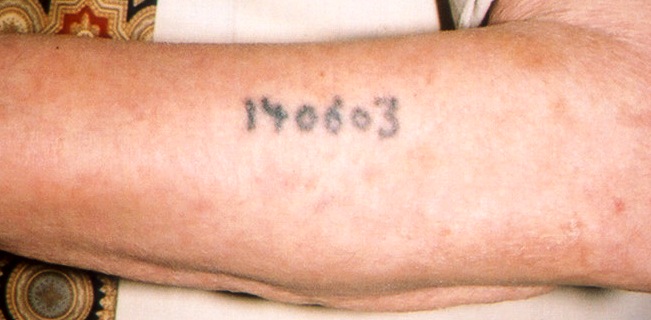 Gruner’s tattoo looks like a real tattoo to me. It looks very similar to the one in this picture at right of Sam Rosenzweig’s arm, which I have posted previously and is the best example of an Auschwitz tattoo I have found. According to George Rosenthal, writing for the Jewish Virtual Library, and accepted by the USHMM, Sam’s tattoo represents the “regular” series of numbers used at Auschwitz from 1940, while the “A” series was first issued in May 1944.
Gruner’s tattoo looks like a real tattoo to me. It looks very similar to the one in this picture at right of Sam Rosenzweig’s arm, which I have posted previously and is the best example of an Auschwitz tattoo I have found. According to George Rosenthal, writing for the Jewish Virtual Library, and accepted by the USHMM, Sam’s tattoo represents the “regular” series of numbers used at Auschwitz from 1940, while the “A” series was first issued in May 1944.
So we have evidence from Grüner and the photograph above of what Elie Wiesel should have on his arm, but doesn’t. There is no point in “Wiesel Believers” continuing to make excuses or look for reasons why their hero Elie won’t come clean about his bare arms. We know he has no tattoo where it is supposed to be … or anyplace! Just look at the top of this website. Or the photo below … from the 1996 documentary film “Elie Wiesel Goes Home.” We see his left arm in bright sunlight; clearly there is nothing on it. In the film we can see his right arm too, many times, which also has nothing on it. What more is there to be said? It’s a slam-dunk, and there is nary a word coming from the Wiesel camp about it. Isn’t it about time? Yes, but nothing happens unless people demand it.
Remember, on March 25, 2010 at the University of Dayton, a student asked Wiesel if he still has his concentration camp number and if it serves as a reminder of those terrible experiences. “I don’t need that to remember, I think about my past every day,” he responded. “But I still have it on my arm – A7713.
Robert A Brown, President of Boston University (Wiesel’s employer) wrote to me on Sept. 27, 2010, after receiving all this evidence, “I have no doubt that he is a survivor of the Holocaust and … a man of integrity and would not stoop to fabrication.“
What do you think?
Grüner False Identity Lawsuit Against Elie Wiesel Set For January 24 in Budapest
by Carolyn Yeager
Myklos Grüner will finally get his day in court!
This writer spoke on the telephone with Grüner in Sweden in September 2010, at which time he assured her he would challenge Wiesel’s identity in a court in Budapest the following January. We know how court dates can be postponed, and even cancelled, but Grüner has proved himself to be a persevering man, and though a year late, it now seems he will indeed present his evidence in court. However, the defendant will not be the highly protected Elie Wiesel himself, but Hungarian rabbi Slomó Köves, who invited Wiesel to Hungary in 2009 while “knowing that (he) is not a genuine Holocaust survivor” but “stole the identity of an inmate,” according to Grüner.
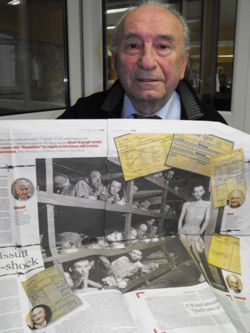 In a news story written by Stefan J. Bos for the BosNewsLife service, dated Friday, Nov. 18, Grüner (pictured right) is reported to have said, “It’s better to sue Wiesel directly, but that is impossible. After 26 years of research, the Hungarian court provides the first opportunity to present my case, which I hope to do by suing the rabbi.”
In a news story written by Stefan J. Bos for the BosNewsLife service, dated Friday, Nov. 18, Grüner (pictured right) is reported to have said, “It’s better to sue Wiesel directly, but that is impossible. After 26 years of research, the Hungarian court provides the first opportunity to present my case, which I hope to do by suing the rabbi.”
Grüner explained, “Elie Wiesel, who lives in the United States, is a very hard man to get. The whole world is protecting him, from [U.S. President] Barack Obama to [German Chancellor] Angela Merkel. They are all scared the truth will come out, because of prestige and money. I am also pressuring the German Bundestag to show me archives about Wiesel’s past. ”Grüner is quoted by Stefan Bos in a private interview on Friday as saying, “I don’t seek financial compensation, but I want [Köves] to tell the world who his friend Elie Wiesel really is. Wiesel was never born in Hungary or Romania as he claims and was not in a concentration camp. He doesn’t even speak Hungarian.” (I don’t know what evidence Grüner has that Wiesel was not born in Hungary or Romania, but I will surely be pleased if he has some.)
Köves denies the accusations against Wiesel. “I was with him two days and Wiesel spoke with me in Hungarian. He also addressed parliament in Hungarian. These allegations are of an elderly man with some kind of complex,” he told BosNewsLife. Köves also told Bos he had not been invited yet for the January 24 court hearing. The 82-year old Grüner has said he is angry at Köves for accusing him of “falsifying history,” and comparing him to American academic Norman Finkelstein who wrote ‘The Holocaust Industry.
It’s possible this could deteriorate into a circus, but one hopes not. Grüner views the court case in Budapest as a giant leap in a long, painful, personal journey, according to the BosNewsLife story. As a 15-year-old boy in Auschwitz whose father had died, he “befriended Lázár Wiesel, who was among those protecting him. In January 1945, as the Russian army was coming, the inmates were transferred from a satellite camp of Auschwitz-Birkenau to Buchenwald in Germany.” The satellite camp was Monowitz, or Auschwitz III, for workers at the IG Farben plant.
Grüner exaggerates the length of time it took the Auschwitz inmates to get to Buchenwald, but he indeed was on that march. (The march itself was only one day, after that they went by train.) Grüner, as well as Lazar and Abram Wiesel, were registered at Buchenwald, but the man we know as Elie Wiesel never was. This is proved by the documents held at Buchenwald. Grüner states in the Bos article that Abram Wiesel, Lazar’s older brother, died on the way, but this is not as he described it in his book Stolen Identity, nor according to Buchenwald records which record Abram Wiesel’s death on Feb. 2, 1945 in Barracks 57.
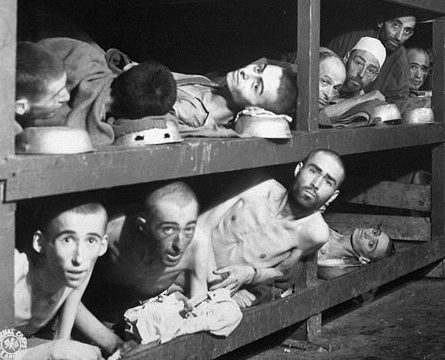 Miklos Grüner, like most holocaust survivors, has memory problems and embellishes his facts … however, he was there and he is in the famous photograph (far left, lower bunk) while Elie Wiesel is not the man at the far right (upper bunk) that he claims is himself. This has been proven on this website Elie Wiesel Cons The World, most recently and thoroughly here.
Miklos Grüner, like most holocaust survivors, has memory problems and embellishes his facts … however, he was there and he is in the famous photograph (far left, lower bunk) while Elie Wiesel is not the man at the far right (upper bunk) that he claims is himself. This has been proven on this website Elie Wiesel Cons The World, most recently and thoroughly here.
According to Bos, Grüner still says that when he was invited to meet Nobel Prize winner Wiesel in 1986, he thought he would be meeting his old friend. Instead it was a man who Grüner claims he never saw before. “Wiesel refused to show me his tattoo. It was a very short meeting.” Grüner said he “doesn’t mind that Wiesel earns 25,000 dollars” for a 45 minute speech.” But I don’t want him to make money on the deaths of my family members and the millions of others who perished in the Holocaust,” he said, his voice trembling. “I want to leave this world knowing that I have told the next generation the truth…I even want a dialogue with Anti-Semites and the Catholic Church, for I later painted as an artist.”
Swedish newspaper article from 1986 of Grüner-Wiesel meeting. Grüner, on left, greets Wiesel, right, in a friendly fashion but is inwardly wondering who he is!
It is our hope that Mr. Grüner succeeds in having his day in court and that he will be able to make his case. It appears that at least the BozNewsLife news service will cover it, and that is good news for us. We know what he is up against, but still we hope.
Elie admits he doesn’t have the tattoo A7713
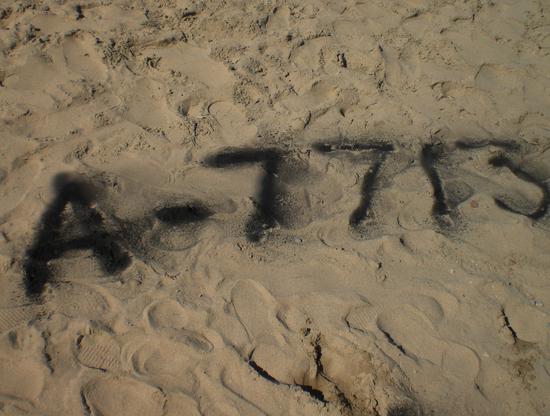
The number A-7713 is hugely important in the life of Elie Wiesel, but not in the way most would think.
By Carolyn Yeager
A7713 IS A NUMBER that is widely recognized because of the story Night written by Elie Wiesel.
According to the story, 15-year old Eliezer had that number tattooed on his left forearm two days after he arrived at Auschwitz-Birkenau in May (or was it April?) 1944.
Wiesel says the story is a true report of his life experience and that he has that number on his arm still today. Yet by refusing to show it to the public for the past 60 years, he is as good as admitting that he does not have it.
In courts of law, whenever a claimant fails to provide proof of his claim, he forfeits his right to that claim. Wiesel has failed to provide proof that he has the tattoo so he must give up the claim. This is the clearest admission he could make, would you not agree? I mean, we’re not talking about a private area of his body that he would not want to expose, but only his left forearm.
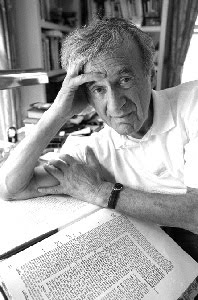
FALSE ALARM. When this image is magnified, the possible “tattoo” is seen to be just a denser area of spots and discoloration on Wiesel’s arm, not in any way a number. See here.
Wiesel keeps his arm covered at all times in public and is never asked about it by the complicit media. However, on a few occasions he must have forgotten and did allow himself to be photographed with bare arms, so we do have a few photos of this part of his anatomy—but with no tattoo visible at all! When asked to comment on that fact, not only Mr. Wiesel, but Mrs. Wiesel, and all Wiesel’s friends and business and academic associates remain totally silent. Even Oprah Winfrey has said nothing about it. This is not a reasonable way to behave.
Now put together the above with the knowledge that Wiesel’s entire fabulous career, success and wealth (including the Nobel Peace Prize and other coveted awards) is dependent on his being Auschwitz prisoner A7713, and you easily see the crucial importance it has for him. There is no debate about it. A7713 is essential to Wiesel’s life story and the prestige and book sales he enjoys today.
Even with all that at stake, he won’t show it to anyone.
This can only be interpreted as an admission that he doesn’t have it. And he knows it. He knows that he has admitted by default that he does not have that tattoo (and therefore is not who he says he is) but he obviously prefers not to say so. He will keep the charade going as long as he lives, which is not much longer.
At this point his admirers and supporters start coming up with harebrained reasons for why he doesn’t have it or why he doesn’t show it. Their “reasons” ignore known facts and common sense, and are easily knocked down. I look forward to receiving some in the comments, although defense for Elie doesn’t have much staying power. His supporters may be starting to realize that it is he who makes them look foolish because of his refusal to engage on the issue. Especially, he refused to engage with Miklos Grüner on the issue—Grüner whose registration and other documentation at Auschwitz is in perfect order and who actually has a tattoo to match.
It was a fateful day for Elie Wiesel when, just off his great triumph at the Nobel Prize ceremony in Oslo in 1986, he went to Stockholm to meet “fellow Buchenwald child survivor” Miklos Grüner on a television show. That short meeting (“Wiesel refused to show me his tattoo”) and the book Night he was given raised Grüner’s suspicions. He began his search for documents relating to Elie Wiesel and Lazar Wiesel.
The result is that we discovered there are no documents at Auschwitz for Elie or Eliezer Wiesel with the birthdate 9-30-1928, nor is there a single photograph of him in any camp. Without the tattoo, Wiesel’s got nothing at all to show he’s a survivor except his own fake memoir.
So let’s stir things up and get the information out there. A huge number of people, institutions and governments are guilty of being complicit in the fraud. It has become one of those “too big to fail” things, and in truth, without Grüner hunting down the documents (which only a former inmate could access), Wiesel would have gotten away with it.
Hats off to Michael Grüner! He’s not perfect but he’s done the world a great service.
“Elie Wiesel Was Not in Buchenwald” Made Simple
[Continuation from “Is it time to call Ken Waltzer a fraud?“]
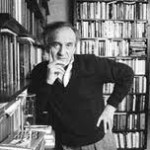 by Carolyn Yeager
by Carolyn Yeager
copyright 2013 carolyn yeager [last updated 12-5-2015]
“In literature, Rebbe, certain things are true though they didn’t happen, while others are not, even if they did.” –Elie Wiesel speaking of his book Night, from his Memoir: All Rivers Run to the Sea
For the skeptics and know-nothings who have written in suggesting Eli Wiesel was not in the camps, that Night is purely fiction, you are all dead wrong. The Red Cross International Tracing Service Archives documents for Lazar Wiesel and his father prove beyond any doubt that Lazar and his father arrived from Buna to Buchenwald January 26, 1945, that his father soon died a few days later. –Kenneth Waltzer in a comment at Scrapbookpages Blog, March 6, 2010.
The story that Michigan State University history professor Kenneth Waltzer has told us about Elie Wiesel in Buchenwald, based on Wiesel’s book Night, is not true.1
Elie Wiesel was not incarcerated at Buchenwald.
He was not liberated from Buchenwald.
He was not a victim of the “Nazis” there.
How do we know that?
Well, how do we know that Elie Wiesel was at Buchenwald?
1. We have a numerical file (registration) card for Lazar Wiesel from Sighet, born 1913.
2. We have a questionaire (Fragebogen) made out for and signed by a Lázár Wiesel, a 16-year old Jew from Sighet.
3. We have a transport list from Buchenwald to France with the name Lazar Wiesel, born Oct. 4, 1928.
4. We see a picture of him in the famous photograph taken in Barracks #56 on April 16, 1945.
5. We have a death report for Abraham Viezel on 2-2-1945, in Block 57.
6. We have a transport list from Auschwitz to Buchenwald with the names Lazar Wiesel, #123565, born 4 September 1913 and Abram Viezel, #123488, born 10 October 1900.
7. We have a photo of the “rescued children” marching out of the Buchenwald main gate on April 27, 1945.
8. We have the book Night, in which he says he was.
* * *
The above list is ordered according to its perceived importance in proving Wiesel was at Buchenwald, so I’ll start from the bottom (least important) in showing that they don’t prove any such thing.
8. The persuasiveness of the book Night has been dealt with in several other places, for example here and here, and is not considered evidence.
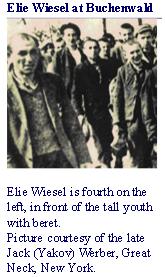 7. Photo of Buchenwald Boys (scroll down a bit). The boy that Ken Waltzer has identified as Elie Wiesel (who was identified to him as such by Jack Werber of Great Neck, NY, a “holocaust survivor” activist) is clearly not Wiesel and has not been identified as Wiesel by anyone other than Ken Waltzer. Waltzer had this image/blurb, at right, on his MSU website for years [the site was removed sometime in 2012], making him look foolish. Will Waltzer admit that he was wrong all this time, or try to sweep it under the proverbial rug?
7. Photo of Buchenwald Boys (scroll down a bit). The boy that Ken Waltzer has identified as Elie Wiesel (who was identified to him as such by Jack Werber of Great Neck, NY, a “holocaust survivor” activist) is clearly not Wiesel and has not been identified as Wiesel by anyone other than Ken Waltzer. Waltzer had this image/blurb, at right, on his MSU website for years [the site was removed sometime in 2012], making him look foolish. Will Waltzer admit that he was wrong all this time, or try to sweep it under the proverbial rug?
6. The Transport List to Buchenwald only proves that Lazar Wiesel, age 31 (a locksmith by trade) and Abram Viesel, age 44, arrived at Buchenwald on January 26, 1945 from Auschwitz. See here and here. Lazar had been given the Buchenwald number 123565, while Abram had 123488. There is no honest way to turn these two into Eliezer Wiesel and his father. Both the birth dates and the names are wrong. It only proves that Elie Wiesel claimed for himself the Auschwitz prisoner number (A7713) of another man. Where is the tattoo on Elie’s arm that reads A7713?
5. The Death Report for Abraham Viezel, Buchenwald prisoner number 123488, same as on the transport list. His death is recorded as taking place in Block 57 on February 2, 1945, not Jan. 29, 1945 as is clearly stated in Night for Eliezer’s father.2
4. The Famous Liberation Photo taken at Buchenwald on April 16, 1945 is said to show Elie Wiesel among the men in the bunks. Beside the fact that the face pointed out as Elie’s doesn’t look like him (for reasons which have been made clear here and here) and that he did not identify himself in it until 1983 when the campaign to get him a Nobel Prize began, there is also his hospitalization which began on April 14th.3 He could not have been near death in a hospital and in the picture at the same time! Ken Waltzer took the liberty of changing the date the photo was taken to April 12 or 13th to get around that inconvenient fact.4
3. The Transport List to France. When did Elie Wiesel’s birthday change to Oct. 4th from Sept. 30th? A majority of boys on this list share the birth year of 1928. The person listed as Lazar Wiesel is the same Lazar Wiesel that the Questionaire refers to, but we have determined that this person could not have been Elie Wiesel. It is true that Elie Wiesel went to France, but how he got there, and when, is not clear.
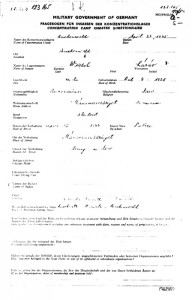 2. The Questionaire [scroll down page] was apparently prepared for and signed by every prisoner prior to their release. It is dated April 22, 1945; the prisoner number is 123165, different by one digit from our previous Lazar Wiesel #123565, and is the number belonging to a recently deceased inmate, Pavel Kun,5 whose death is recorded as March 8, 1945. Since Elie Wiesel allegedly received his number upon arrival on Jan. 26, 1945, he would not later be given a new number from a prisoner who just died. It would seem from this that Lázár Wiesel is a newcomer-of-sorts who had been given a number that had just been released.
2. The Questionaire [scroll down page] was apparently prepared for and signed by every prisoner prior to their release. It is dated April 22, 1945; the prisoner number is 123165, different by one digit from our previous Lazar Wiesel #123565, and is the number belonging to a recently deceased inmate, Pavel Kun,5 whose death is recorded as March 8, 1945. Since Elie Wiesel allegedly received his number upon arrival on Jan. 26, 1945, he would not later be given a new number from a prisoner who just died. It would seem from this that Lázár Wiesel is a newcomer-of-sorts who had been given a number that had just been released.
The name Lázár is spelled with distinct, heavy accent marks; the birth date given is Oct. 4, 1928 (Elie’s is Sept. 30); date of arrest is April 16, 1944 (Elie’s family’s deportation was at the end of May/early June – see here); the signature on the back does not match Elie Wiesel’s known signature or handwriting. The signature is also written with accents over the a’s in Lázár, implying that the accenting originated with Lázár and not with the official who filled out the form.6
But, beyond all this, on April 22 Elie Wiesel was in a hospital in or near Buchenwald camp “hanging between life and death” after coming down with severe food poisoning. He was taken to the hospital on April 14 and not released until April 28, according to his own words in his “autobiographical” Night and his 1995 memoir All Rivers Run to the Sea. Therefore, he could not have been interviewed or signed the questionaire on April 22nd. (See Endnote 3)
1. The Numerical File Card (below), made out at registration, is for Lazar Wiesel from Maromarossziget, born Sept. 4, 1913, making him at the time 31 years old. His Buchenwald prisoner number 123565 is written on the upper right. The card indicates his father, Szalamo Wiesel, was also at Buchenwald, while his mother, Serena Wiesel, nee Feig was currently interned at KL Auschwitz (at the time of Jan. 26, 1945).
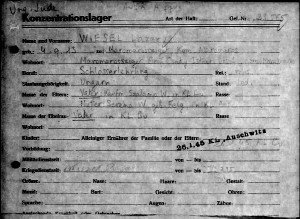 This registration card is the only item that casts some doubt7 over Nikolaus Grüner’s account of Lazar and Abram. But it does not prove that this Lazar Wiesel is Elie Wiesel. It does not make any sense that all the birth dates for the same person would be different! It makes more sense that there were several persons with similar names.
This registration card is the only item that casts some doubt7 over Nikolaus Grüner’s account of Lazar and Abram. But it does not prove that this Lazar Wiesel is Elie Wiesel. It does not make any sense that all the birth dates for the same person would be different! It makes more sense that there were several persons with similar names.
Note that this card identifies Lazar Wiesel as a locksmith (Schlosserfehrling), a trade of which the 15-year-old Elie Wiesel never would have identified himself. In Night he identified himself upon entry to Auschwitz as “a farmer” (p. 32, MW translation) and continued not to boast of any skill (of which he had none anyway) so as not to be sent out for work.
* * *
So we end up realizing there is no evidence that Elie Wiesel ever set foot in Buchenwald in 1945. What’s more, he and others (including Ken Waltzer) have actively and knowingly lied about photographs, dates, times, names, etc. This has gone on with the blessing and support of Yad Vashem Holocaust Memorial in Israel, the US Holocaust Memorial Museum in Washington DC, the New York Times Company, Associated Press, and other establishment media – and the multitude of Jewish/Holocaust-promoting organizations across the globe. Think of Elie Wiesel conducting US President Obama and German Chancellor Merkel around the Buchenwald Memorial in 2009! It is a giant criminal conspiracy when one really takes a look at it. The ramifications are immense.
Someone, preferably Elie Wiesel, needs to explain all the discrepancies in his tale. He has never offered to and never been asked to. If Wiesel won’t attempt an explanation, then Ken Waltzer the Historian with the PhD from Harvard University must do so. In his scholarly studies, Waltzer includes Elie Wiesel as one of the “Rescued Children of Buchenwald. ” One duty of a scholar is to answer serious and justified questions about their work. Elie Wiesel Cons The World is asking such questions and so we await an answer.
Update 6-15 Great idea from a reader: Write to Prof. Ken Waltzer at [email protected] and ask him politely to answer the questions raised in this article.
Endnotes:
1. Prof. Kenneth Waltzer has removed this article from the Internet, along with his entire website which the article had been a part of for several years, and says he has written a new separate article on Elie Wiesel in Buchenwald.
The book is on track, and I have also completed a separate essay to be published on Elie Wiesel and Buchenwald. -Ken Waltzer to me, Carolyn Yeager, in an email, March 2013
He obviously doesn’t want comparisons made between his old and new article and is waiting as long as possible to make it public. Or is he still reworking it?
2. “Then I had to go to sleep. I climbed into my bunk, above my father, who was still alive. The date was January 28, 1945. I woke up at dawn on January 29. On my father’s cot there lay another sick person. They must have taken him away before daybreak and taken him to the crematorium.” –Night, 2006 Marion Wiesel translation, p. 112
The Yiddish original, Un di Velt Hot Gesvign, says Father’s death occurs on the 18-19 of Shevat:
For a couple of hours I stayed by him and looked at his face long and well […] Then they forced me to go lie down to sleep. I climbed up to the uppermost bunk and I did not know that in the morning, on awakening, I would find my father no more.
It was the eighteenth of Shevat, 5705.
Nineteenth of Shevat. Early in the morning.
I got up and ran to my father. Another sick man was lying in his place.
I had a father no more. (p 238)
Readers might be surprised to learn that the Hebrew calendar date of 18-19 Shevat, 5705 corresponds to February 1-2, 1945. This gives credence to the idea that Abram Viezel’s death is the model for the story And The World Remained Silent. The date in the original story for Father’s death and the date of Buchenwald records for Abram’s death concur. This leads me to question Elie Wiesel’s personal knowledge of events at Buchenwald because why would he change the date to Jan. 28-29 if he knew the significance of Feb. 1-2?
Also, the death took place in Block 57, the report said, which would seem to be next door to Block 56 where the famous Buchenwald liberation photo is said to have been taken.
3. “Three days after the liberation of Buchenwald, I became very ill: some form of food poisoning. I was transferred to a hospital and spent two weeks between life and death.” –Night, 2006 Marion Wiesel translation, p. 118
Also in Un di Velt Hot Gesvign (the original Yiddish story from which Night was taken), p.244:
“Three days after liberation I became very ill; food-poisoning. They took me to the hospital and the doctors said that I was gone. For two weeks I lay in the hospital between life and death. My situation grew worse from day to day.”
Another question that occurs is: Of all the photos taken in Buchenwald after liberation, why don’t we find even a single one with Elie Wiesel in it? Knowing he wasn’t there at all may be why he liked the food poisoning/hospitalization story – it can explain why he doesn’t show up in any photograps. But it totally contradicts the “evidence” of the Questionaire and of his being in the famous barracks #56 photo.
4. Waltzer wrote in his article:
“He [Elie] was too weak at liberation on April 11 to leave his barracks (hence he was photographed in a famous picture in the barracks on April 12 or 13), and he came to understand he was free only days later.”
Waltzer trapped himself again. The officially declared date of the photo is April 16, which is well established. Waltzer is simply trying to evade with lies the serious problem of Wiesel going into the hospital 2 days before the photo was taken. This is NOT how a respectable, responsible historian does things.
In addition, Waltzer is saying that the photograph was taken in the children’s barracks #66, which is utterly wrong. The official description says it was barracks #56, for men, or possibly a sick barracks. If Abram Viezel was in a sick barracks when he died (#57), then #56 might also be an “infirmary” barracks.
5. Pavel Kun is on the transport list of Jan. 26, 1945 from Auschwitz to Buchenwald. He appears under the section Politische Slowakan Juden; his birth date is July 6, 1926, making him 18 when he died.
6. Revisionist Carlo Mattogno concluded, after studying these documents, that Lazar Wiesel, Lázár Wiesel and Elie Wiesel are not the same person.
In conclusion, we can say that Elie Wiesel can be neither Lazar Wiesel, nor Lázár Wiesel, nor Lazar Vizel and that the ID number A-7713 was not assigned to him but to Lazar Wiesel, while ID A-7712 was not assigned to his father but to Abram (or Abraham) Viesel (or Wiesel).
The charge of identity theft raised against Elie Wiesel by Miklos Grüner does not concern Lazar Wiesel only, but Lázár Wiesel as well: from the former, he took the Auschwitz ID number (A-7713), from the latter the stay at Buchenwald and the later transfer to Paris. –http://revblog.codoh.com/2010/03/elie-wiesel-new-documents/#more-837
7. Szalamo seems likely a Hungarian spelling for Shlomo. Serena Feig is close but not Elie’s mother’s name, which was Sarah Feig. According to this card, Lazar had a father in the camp, something that was not mentioned by Nikolaus Grüner. Ken Waltzer will say this proves that Lazar Wiesel is Elie Wiesel, but what about the very wrong birthdate? Why don’t we have a card for Szalamo too? These cards are kept at Bad Arolson, not at the Buchenwald Memorial Museum Archive; only people with special permission (like Waltzer) have access to them.
Is it time to call Ken Waltzer a fraud?
By Carolyn Yeager
copyright 2013 Carolyn Yeager
Updated April 7th
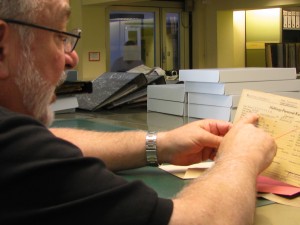
Prof. Kenneth Waltzer is looking at a Buchenwald registration card at the International Tracing Service in Bad Arolsen, Germany.
Kenneth Waltzer is a professor of history at Michigan State University since the early 1970’s. He helped to create the Jewish Studies program which opened in 1992, and which he heads. Waltzer has been researching into evidence of a special ‘boy’s protection program’ run by prisoners at Buchenwald for going on 10 years now. As an “approved” researcher, he is allowed to peruse all the files at the International Tracing Service in Bad Arolsen, Germany, something that is made much more difficult, if not impossible, for revisionists.
Waltzer is considered one of the top scholars in the U.S. of the ill-named holocaust but his work has been sloppy, and his attempts to cover up the sloppiness amount to fraud. This, along with his continual promotion and defense of Elie Wiesel as a Buchenwald survivor, is what has drawn me to study him ever more closely.
Because of the seriousness of the charge I am making against him, I will list right up front my reasons for thinking it is time for such a call. They are:
- Waltzer habitually tells fibs in the form of false information which is intended to mislead. When called out for it, he tells more fibs to cover for the first ones.
- He has been in the service of the “Holocaust Industry,” not academic rigor and fair-mindedness, from the very start of his career.
- He knowingly defrauds his students, his university and the public (you and I) with his dishonest “holocaust scholarship.”
- While he is drawing high pay as a tenured American professor of history at MSU, he is working to advance the State of Israel.
I am going to show that these charges have a strong basis in fact. Fraud is commonly understood as dishonesty calculated for advantage. A person who is dishonest may be called a fraud. In the U.S. legal system, fraud is a specific offense with certain features. (see here)
Legally, fraud must be proved by showing that the defendant’s actions involved five separate elements: (1) a false statement of a material fact, (2) knowledge on the part of the defendant that the statement is untrue, (3) intent on the part of the defendant to deceive the alleged victim, (4) justifiable reliance by the alleged victim on the statement, and (5) injury to the alleged victim as a result.
I am not intending to bring legal charges of fraud against Prof. Waltzer, but to try him in the court of public opinion. Therefore, it will be up to Waltzer to defend himself against my charges.
* * *
Two years ago, I asked the question on this web site: “What happened to Ken Waltzer’s book about the boys of Buchenwald?” It was claimed to be, at that time, in it’s final stages. Eight years after he publicly announced he was researching for a book about the so-called children’s barracks at Buchenwald (Barracks #66 ), it still has not materialized. Five years after his book was described as “upcoming,” it still has not materialized. During this time, he has not produced another book, or any major work that would have taken precedence over this book. So what is the delay?
It’s pretty plain that the book’s thesis has shifted considerably since 2005, when his MSU website featured Elie Wiesel as the most recognizable and famous child survivor from Buchenwald. That website was taken down between one and two years ago and is completely wiped clean from the Internet. The banner on all the six to eight pages that were included showed a photograph very similar to the one below of the “boys” being marched out of the main Buchenwald camp to temporary quarters at the former SS barracks.
The USHMM (national holocaust museum in D.C) website dates this picture as being taken on April 17, 1945, six days after liberation.1 At this time, Elie Wiesel, by his own account in two books, was laying in a hospital sick almost unto death from food poisoning. Details like this don’t deter Prof. Waltzer from backing up in every instance the standard holocaust narrative. “Elie Wiesel in Buchenwald” is the standard narrative, so evidence must be found for it.
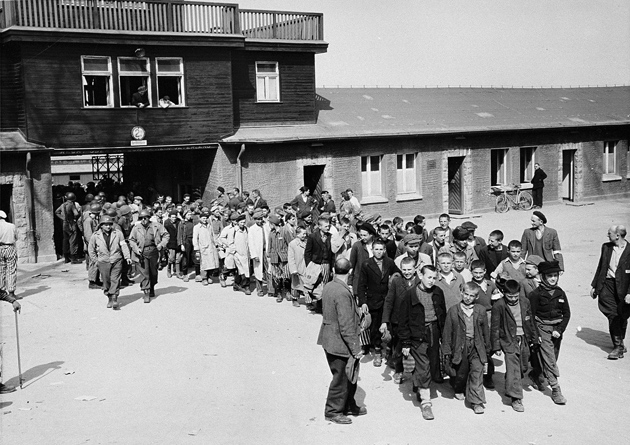 Ken Waltzer claimed for years that one of these boys was Elie Wiesel. But Wiesel is not in this picture!
Ken Waltzer claimed for years that one of these boys was Elie Wiesel. But Wiesel is not in this picture!
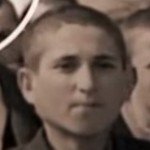 From at least 2005 (eight years now), Waltzer has identified the boy third or fourth from the front (hard to tell) in the left-side column (dressed in a black suit and in front of the tall boy wearing a beret) as Elie Wiesel, based on nothing but his own fraudulent intention that there was enough resemblance that people would believe it if he said so. In this article , I exposed this lie. Waltzer has never admitted that he was mistaken or was perpetrating a falsehood that he intended to put into his book. Instead, what he did when his fabrication was sufficiently exposed was to take the entire site down and not mention it again.
From at least 2005 (eight years now), Waltzer has identified the boy third or fourth from the front (hard to tell) in the left-side column (dressed in a black suit and in front of the tall boy wearing a beret) as Elie Wiesel, based on nothing but his own fraudulent intention that there was enough resemblance that people would believe it if he said so. In this article , I exposed this lie. Waltzer has never admitted that he was mistaken or was perpetrating a falsehood that he intended to put into his book. Instead, what he did when his fabrication was sufficiently exposed was to take the entire site down and not mention it again.
Left is a close-up of the boy Waltzer has maintained for several years is Elie Wiesel. Anyone can tell it is not and that’s why no one else ever publicly agreed with him.
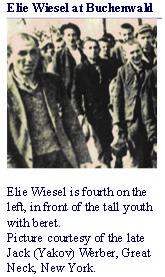 I have some of what was on that site copied into articles here at EWCTW and also in my files. At left is the cropped section of the photo that Waltzer used on the banner of his MSU-Newsroom/Holocaust website that was very much dedicated to Elie Wiesel. (Another reader, Chris, informed me that he had found pages from the site using the Way Back Machine. Many thanks to him.) This shows that Waltzer definitely identified the boy in the black suit as Elie Wiesel. In addition, Jack Werber, a known dishonest survivor, was the supposed supplier of the picture.
I have some of what was on that site copied into articles here at EWCTW and also in my files. At left is the cropped section of the photo that Waltzer used on the banner of his MSU-Newsroom/Holocaust website that was very much dedicated to Elie Wiesel. (Another reader, Chris, informed me that he had found pages from the site using the Way Back Machine. Many thanks to him.) This shows that Waltzer definitely identified the boy in the black suit as Elie Wiesel. In addition, Jack Werber, a known dishonest survivor, was the supposed supplier of the picture.
Below right, a screen shot of one of the pages as it existed then, sent by a friend of EWCTW. It shows more of the emphasis on Elie Wiesel.
When I pointed out much of this in a podcast of March 25th, Waltzer sent me an email on March 28th stating,
My websites at UM FLint are down because I was appointed there one year and am now back at Michigan State.
Of course I never mentioned UM Flint and never even saw his website there. I was speaking about his MSU website, which was titled something like Ken Waltzer’s “MSU Newsroom Special Report.” It was full of information about his projects and especially what he calls “the rescue operation of children at Buchenwald.” It was up on the Net since at least 2008 2, then suddenly disappeared, with not even cache pages to be found. Did Waltzer tell me a fib, or did he just read the podcast program description and misinterpret what it said about “taking down web pages?” By now, he will know what I mean and may answer.
 I think it is very possible that he timed the take-down of his MSU “Newsroom” site with his one-year visiting professorship at UM Flint — putting up a temporary website there which he could take down when he left. This is a way of confusing the picture in order to distract as much as possible from his more recent decision to put more distance between himself and his prior (false) assertions about Elie Wiesel.
I think it is very possible that he timed the take-down of his MSU “Newsroom” site with his one-year visiting professorship at UM Flint — putting up a temporary website there which he could take down when he left. This is a way of confusing the picture in order to distract as much as possible from his more recent decision to put more distance between himself and his prior (false) assertions about Elie Wiesel.
His intention was and is clearly to deceive. The harm is caused to ordinary people who believe and trust that they are getting knowledgeable answers from a professor of history and a holocaust scholar. In this particular case, all five of the elements necessary to prove fraud are there.
First, he sets up a University-sponsored website maintaining falsely that Elie Wiesel is the boy in the photograph of youthful “survivors” marching out of the camp (1). He knows it is false because he has no evidence or proof, only his own “wishful thinking.” The USHMM never identified Wiesel in that group of boys, nor did anyone else (including Wiesel himself), unless they did so from following Waltzer’s example (2). Waltzer’s intent was to make the public believe something that was not true – that he had proof of Elie Wiesel being one of the “rescued children” (3). Because Waltzer is a Professor of History and “holocaust expert” at a major university, and is at all times written up very favorably in the media, the public (you and I ) and his students will rely on his statements (4). These same students and public are injured when photographs are mislabled in order to foist on them a certain belief about an influential historical event that affects their entire world view (5).
* * *
This is just one instance of the untruths that Ken Waltzer has told over the years. Another tactic he uses is to promise an upcoming answer to your doubts which he cannot or does not produce now. As we have seen, we continue to wait as he continues to promise. Still another tactic is to accuse others of lying when it is he who is doing so. But only people who are knowledgeable enough about these complex and purposely obscured issues can see who is doing the lying. In this same email, he wrote:
The book is on track, and I have also completed a separate essay to be published on Elie Wiesel and Buchenwald.
Completed, he says. And separate. Why separate? I wrote back to him asking where I could find his essay because I wanted to read it. No reply – which is typical because factual information is not his forte, emotional rhetoric is. I feel it’s quite possible he wrote a separate essay on Elie Wiesel so as not to tarnish his book with the false “facts” about Wiesel in Buchenwald. He can always get rid of an essay, if necessary, later – but not his entire book. What might there be in this essay? Will it be the same or quite different from what he wrote in a March 6, 2010 comment at Scrapbookpages Blog, when he said [my underlining-cy]:
For the skeptics [I was using the name skeptic then -cy] and know-nothings who have written in suggesting Eli Wiesel was not in the camps, that Night is purely fiction, you are all dead wrong. The Red Cross International Tracing Service Archives documents for Lazar Wiesel and his father prove beyond any doubt that Lazar and his father arrived from Buna to Buchenwald January 26, 1945, that his father soon died a few days later, and that Lazar Wiesel was then moved to block 66, the children’s block in the little camp in Buchenwald. THese documents are backed up by military interviews with others from Sighet who were also in block 66, and by the list of Buchenwald boys sent thereafter to France. All of this is public domain.
Wishful thinking by Holocaust deniers will not make their fantasies true. While Wiesel took liberties in writing Night as a literary masterpiece, Night is rooted in the foundation of Wiesel’s experience in the camps. The Buchenwald experience, particularly, runs closely to what is related in Night.
Comment by kenwaltzer — November 14, 2010 @ 6:57 am
How much untruth is contained in this, in order to defraud us all in his devoted service to the “Holocaust Industry” and the state of Israel? Plenty. As proof that Elie Wiesel was in Buchenwald, he points to documents for Lazar Wiesel and “his father.” It is even more absurd because Lazar Wiesel’s relative was only 13 years older than Lazar – it was in fact his brother Abram! Waltzer is passing off Lazar for Elie simply on the basis that Lazar also came from Sighet, Elie’s hometown and carries the same name. Sighet was a city of 50,000 or so with a very large Jewish population, and Wiesel was a common name. But the “scholar” who has taken years to research this and still isn’t finished, wants us to believe there can be only one Lazar Wiesel, who is Elie. He attributes the difference in their birthdates to bureaucratic error.
Previously I may have called this stupidity, but now I’m calling it fraud, based on the above-given definition. Of course Waltzer can see the discrepancies here, but he hopes he can convince you not to see them. The Military Interview mentioned with Lázár Wiesel’s name on it also does not have the right birthdate for Elie Wiesel, nor does the signature match Elie’s well-known signature.
Will Waltzer repeat this nonsense in his latest “completed” essay? Notice that Waltzer never fails in the name-calling department, here calling his critics names such as “know-nothings” and “Holocaust deniers.” Several months later, he wrote a similar comment at EWCTW to the blockbuster article: “Signatures Prove Lázár Wiesel is not Elie Wiesel”
On November 14, 2010 at 10:34 am
Contrary to Carolyn Yeager’s wishful thinking, Eli Wiesel was indeed the Lazar Wiesel who was admitted to Buchenwald on January 26, 1945, who was subsequently shifted to block 66, and who was interviewed by military authorities before being permitted to leave Buchenwald to go with other Buchenwald orphans to France. Furthermore, there is not a shadow of a doubt about this, although the Buchenwald records do erroneously contain — on some pieces — the birth date of 1913 rather than 1928. A forthcoming paper resolves the “riddle of Lazar” and indicates that Miklos Gruner’s Stolen Identity is a set of false charges and attack on Wiesel without any foundation.
The promise of a forthcoming paper turned out to be a fib. From Nov. 2010 to now, there has not been any paper. Maybe it’s the essay he mentioned in his March 28th email? “Forthcoming” to Waltzer means up to two and a half years, it seems. That in itself is the sign of an unreliable person.
There can be only one reason Ken Waltzer allows himself to look like a buffoon and a shyster. He doesn’t need to do it to keep his position at Michigan State University. He does it because it is his larger job to keep the Buchenwald atrocity stories and Liberation lies, including the Elie Wiesel myth, alive and well in the mind of the public. He works for purely Jewish interests – I will be writing a future article on the priority, meaning and funding of Jewish Studies programs in American universities. For now, I can add that Waltzer is more of a public relations (PR) worker for the Holocaust Industry, the State of Israel and maybe AIPAC, than he is an honest-to-god academic. Another organization connected to Israel that he serves is Scholars for Peace in the Middle East. He has written four attack-dog articles for them since 2009, functioning in a sort of Abe Foxman-pitbull style.
In Nov. 2009, he attacked Alison Wier as another “know-nothing” because she speaks up for Palestinian rights on college campuses, where she is popular.
In May 2010, he went after John Mearsheimer for calling Israel “an apartheid state” and also took out after Noam Chomsky, Norman Finkelstein, and “the crackpot Phil Weiss.”
Also in May 2010, another target was Judith Butler, who campaigned at the Berkeley campus for the university “to divest from companies making military weapons which Israel employs to commit war crimes.”
In August 2011, he wrote on the Israeli-Palestinian peace process, arguing for Israel’s interests to be well and strongly presented on college campuses.
But this is only the tip of the iceberg when it comes to Walzer’s pro-Israel activities. I will be writing further articles that present the evidence for Ken Waltzer being guilty of fraud in his public writings and during his entire career. Much of it revolves around Elie Wiesel and the Industry’s need to place him at Buchenwald. My position, if you have somehow missed it, is that Elie Wiesel was never at Buchenwald. I am also saying that Waltzer is backing down or “stepping back” from his blatant, dishonest claims about Wiesel, but he can’t back down altogether.
Endnotes:
1. I have also seen it dated April 27 at the USHMM and have used that date in other articles here. Now I have only found this one picture which is very officially dated the 17th. There may have been an attempt to move the date to the 27th so that Wiesel could be in the picture (though he supposedly would not have been released from the hospital until the 28th). It is really too bad the USHMM cannot be relied upon; nor can Yad Vashem. When the museum “researchers” are involved in lying or in complacency, one really has nowhere to turn.
2. http://msutoday.msu.edu/news/2008/mapping-the-holocaust-archive-msu-prof-explores-records-of-nazi-atrocities At bottom of article, it reads “For more information, and to follow Waltzer’s research and read his journal as he participates in the workshop, visit the special report at: http://special.newsroom.msu.edu/holocaust.” This is a link to the website that no longer exists, as you will see if you click it. Now he seems to be pretending it was never there.
Waltzer’s Boys of ‘Buchenwald’ book?
Waltzer’s Boys of ‘Buchenwald’ book?
by Carolyn Yeager
MSU Prof. Kenneth Waltzer has been promising his book The Rescue of Children and Youth in Buchenwald since 2007. Four years later, he’s being very quiet about it.
Here is a timeline of announcements about this work in progress, all taken from his Michigan State University website.
May 2005: Professor Waltzer presented a paper, “The Rescue of Children at Buchenwald: Behavior in a Grey Area,” at the Midwest Jewish Studies Scholars Colloquium, Cohn-Haddow Judaic Studies Program, Wayne State University, Detroit.
March 2007: Ken Waltzer will present a paper on “The Kovno Boys: Survival at Auschwitz, Buchenwald, and Mauthaussen,” at the 37th Annual Holocaust Scholars Conference in Cleveland, Ohio.
April 2007: Ken Waltzer presents on his book-in-progress, The Rescue of Children and Youth in Buchenwald, at James Madison College.
May 2008: MSU Professor Ken Waltzer gave the Monna and Otto Weinmann Lecture at the U.S. Holocaust Memorial Museum on the subject of his upcoming book on the rescue operation at Buchenwald that he said saved the lives of hundreds of children and youths.
April 2010: Kenneth Waltzer, professor of history and director of the Jewish studies program at Michigan State University, is currently completing a book about the rescue of children and youths at Buchenwald. [From the April 16, 2010 The Jewish Daily Forward]
The Elie Wiesel Problem
Prof. Waltzer has written and shown pictures of himself (right) doing research at Bad Arolson in Germany, seeking to discover details about the lives and families of the boys of Buchenwald. One of the boys that he may be having trouble with is Elie Wiesel. Waltzer has made a lot of claims and put himself on the line about Wiesel that, in this writer’s opinion, cannot be substantiated.
For example, last November Waltzer commented on this website to my article “Signatures Prove Lázár Wiesel is not Elie Wiesel” with the following:
Contrary to Carolyn Yeager’s wishful thinking, Eli Wiesel was indeed the Lazar Wiesel who was admitted to Buchenwald on January 26, 1945, who was subsequently shifted to block 66, and who was interviewed by military authorities before being permitted to leave Buchenwald to go with other Buchenwald orphans to France. Furthermore, there is not a shadow of a doubt about this, although the Buchenwald records do erroneously contain — on some pieces — the birth date of 1913 rather than 1928. A forthcoming paper resolves the “riddle of Lazar” and indicates that Miklos Gruner’s Stolen Identity is a set of false charges and attack on Wiesel without any foundation. ~~ by kenwaltzer on November 14, 2010 at 10:34 am
The birthdate on Lazar Wiesel’s records is erroneous—that’s his answer? He is going to “resolve” that? The “forthcoming paper” has not yet appeared 7 months later. His website pages have not been updated for awhile; in fact, they look downright dormant.
Here are the problems I think Waltzer is having, in addition to the birthdate problem:
- He has claimed for at least several years that a picture he has placed on his website of the boys walking out of the Buchenwald front gate shows Elie Wiesel “toward the left.” [See The Many Faces of Elie Wiesel] I say it is not Elie Wiesel, and I don’t know anyone but Waltzer who has identified this boy as Elie Wiesel. This picture is also shown on the USHMM website, and they make no mention of Elie Wiesel as one of the boys.
- In a Power Point presentation that is available on his website, Waltzer shows a group picture of the ‘religious boys’ out of those who went to France, that he says includes Elie Wiesel. I have studied this picture closely and do not see anyone who resembles Wiesel. If Waltzer knows that Elie Wiesel is in the picture, why doesn’t he identify him with an arrow?
Famous Buchenwald Liberation photo is another problem
As I pointed out in “The Many Faces of Elie Wiesel,” the pictures that Waltzer claims contain the face and person of Elie Wiesel do not resemble each other. The famous barracks photo which the New York Times declared to be Elie Wiesel as a 16-year old Buchenwald inmate—and is reproduced all over the world as Elie Wiesel—doesn’t look like the other 16-year old faces.
This writer suspects that Ken Waltzer is having difficulty convincingly incorporating Elie Wiesel into the story of the “boys of Buchenwald” and their rescue. He has been a friend and devotee of Wiesel for many years, they are both strongly associated with the U.S. Holocaust Memorial Museum, and Wiesel has been a part of his Buchenwald story from the beginning. But the real evidence for Elie Wiesel ever being an inmate at Buchenwald doesn’t exist. There are no photographs of Elie Wiesel at Buchenwald, and none of him at the Ecouis School in France. There are no photos of Wiesel during his supposed concentration camp period at all.
I think Waltzer believed this slipshod approach he employs would pass without comment, but he didn’t count on the appearance of Elie Wiesel Cons the World website. We are a real problem for Ken Waltzer!
Ken Waltzer Replies
Ken Waltzer Replies
By Carolyn Yeager
(Last edited on July 3 and added to on July 9)
In my previous blog of June 14, I asked the question “What happened to Waltzer’s book about the ‘boys of Buchenwald?’” On June 27, Ken Waltzer (pictured right) answered me … sort of. He said he was not having any trouble with the book, but he didn’t say when we could expect to read it. Not a word on that. But he assured Elie Wiesel Cons the World readers that we will find it a powerful story when we do.
Being a person who likes to stick with the practical and real, I’m not satisfied with Prof. Waltzer’s answer because it avoids the real questions in favor of repeating his claims without supporting them. On top of that, he called me a bigot. This is a grievous fault, it seems to me, in a man who is a Professor of Jewish Studies and German History at Michigan State University. Let’s take a look at what he’s said.
Before writing a comment to my blog, Waltzer first wrote a comment on June 26 to Scrapbookpages Blog. The blogmaster there, who goes by the name of “furtherglory,” had blogged June 16 on my ‘boys of Buchenwald’ article. He checks out new articles about Holocaust on the Internet daily, and seems pretty interested in Elie Wiesel. He added an update to the original blog and asked the question: “Has Ken Waltzer finally figured out that there were three separate people involved in this controversy and all three are named Wiesel.” No, he hasn’t. Waltzer continues to insist that they are all Elie Wiesel.
This is what Ken Waltzer said on Scrapbookpages Blog:
All the ridiculous claims that Wiesel was not Wiesel, Wiesel was not at Buchenwald, Wiesel was a different Wiesel are false, There was one Lazar Wiesel at Buchenwald. He arrived with his father, who appears as Abram, born 1900, and who died shortly after arrival. (He signs his name Shlomo.) Wiesel was then moved to block 66, the children’s block, part of a large child-saving operation by people aligned with the German-Communist led international underground in the camp. He is there with others from Sighet who affirm he is there. He is there until liberation. He is interviewed by American military authorities there. He goes to France.,…
There is no question, indeed there is firm proof, Elie Wiesel was at Buchenwald. And the sections of Night written about Buchenwald are generally accurate and conform to the experience he had.
Comment by Ken Waltzer — June 26, 2011 @ 6:53 am
And this is what Furtherglory said in reply:
Thanks for your comment. A man named Lazar Wiesel was given the tattoo number A-7713 at Auschwitz. A man named Abram Viesel was given the number A-7712 at Auschwitz. Both of them were transferred to Buchenwald in January 1945. Lazar Wiesel, born at Maromarossiget on 4 September 1913, an apprentice locksmith, political detainee and Hungarian Jew, was registered at Buchenwald on 26 January 1945 and assigned the ID number 123565. This must be the man whom you have identified as Elie Wiesel and Abram Viesel is the man that you have identified as Elie’s father. In the records at Auschwitz, Abram Viesel was born on 10 October 1900 at Marmarosz. He was old enough to be Elie Wiesel’s father, but not old enough to be the father of Lazar Wiesel, who was born in 1913, according to the records.
Elie’s full name is Eliezer Wiesel and he was born in Sighet, Romania (Marmarossiget) which was a part of Hungary in 1944. Elie claims he was born on September 30, 1928. Are you saying that his birthdate was mistakenly written as Sept 4, 1913 at Buchenwald?
A man named Lázár Wiesel, (note difference in spelling) born 4 October 1928, was also registered at Buchenwald and given the ID Number 123165. Are you saying that this man did not exist?
You wrote that Elie Wiesel (Lazar Wiesel) was interviewed by the American military. Lázár Wiesel filled out a US Army questionaire on 22 April 1945 at Buchenwald; he stated on the questionaire that he was born at Màromarossziget on 4 October 1928; he was a student who was arrested on 16 April 1944 and interned at Auschwitz and Monowitz. Are you saying that this man didn’t exist?
The records at the Buchenwald Gedenkstätte show that Lázár Wiesel was sent to Paris on 16 July 1945 with a convoy of surviving children and is registered on the transport list. The name Lazar Wiesel is not on the transport list to Paris, which makes sense since he was born in 1913.
Lazar Wiesel’s name was on the transport list from Auschwitz to Buchenwald, but the name Lázár Wiesel was not. That doesn’t mean that Lázár was never at Auschwitz. He could have been sent, from Auschwitz, to some other camp, such as Gross Rosen, and then sent to Buchenwald when Gross Rosen, or whatever other camp, was evacuated.
Comment by furtherglory — June 26, 2011 @ 3:40 pm
It didn’t take furtherglory long to answer Prof. Waltzer and I thought he did a fantastic job. I mean, he’s got it all right and in order and that’s why I’m copying it here … so I won’t have to do it myself. Furtherglory asked Prof. Waltzer some questions, but Waltzer has not yet answered them. I have a feeling he won’t, either, because he doesn’t like to answer questions that he hasn’t posed himself, or are not easy ones. You see, Waltzer spends most of his time talking to his brainwashed students or to Jewish people at Jewish group events, like at the U.S. Holocaust Memorial Museum. Did you know that Jews run that museum and make up most of the attendees at its events? See here. They never ask tough questions.
But still, I was very happy to find a comment on my blog from Prof. Waltzer and I thank him for it. I think it says a lot for him that he is willing to engage, even if only to this extent. He wrote:
by Ken Waltzer On June 27, 2011 at 2:26 pm
Carolyn Yeager suspects that Ken Waltzer is having trouble with his Buchenwald book, esp. proving Elie Wiesel was at Buchenwald as he says he was. Nothing could be further from the truth.
The Buchenwald book is drawn on survivors’ experiences interviewed around the world and on documents from the Red Cross ITS and it will tell a powerful story of endurance and rescue inside Buchenwald.
And related to that larger story, in which Elie Wiesel is merely one of many boys who were helped and saved inside Buchenwald, there simply is no mystery whatsoever of Elie Wiesel, as Yeager claims. He arrived from Buna on a terrible transport on Jan. 26, 1945, with many others (including Miklos Gruner); he was accompanied by his father, who was recorded as Abram (but who signed his name as Shlomo); they were initially together in a barrack in the little camp, 59, I think, and then — after his father died — Elie Wiesel was moved in early February to block 66, the kinderblock. Miklos Gruner too was in block 66. Elie Wiesel was there with other boys from Sighet, who knew him; he was interviewed by military authorities after liberation, in order to permit departure from the camp; and he went after liberation in early June, 1945, to France, to Ecouis…. one among 425 boys who did so. He appears in subsequent pictures at Ambloy and Taverny where the religious boys were taken after Ecouis….
More important, Elie Wiesel’s commentary in Night bears fairly close resemblance to the actual experiences he had at Buchenwald — as recorded in camp documents.
He is the truth teller — Carolyn Yeager; you are the dealer in false claims and bigoted charges.
I am a bigot for doubting Elie Wiesel. I guess it’s some form of antisemitism to doubt that every word Elie Wiesel says is absolutely true … because he is the truth teller, according to Waltzer. And he, Waltzer, is going to prove it.
I consider what Prof. Waltzer is doing similar to ‘sleight of hand.’ He‘s repeating what he’s been saying all along … with a few convenient omissions (for example, the paper proving it he promised 6 months ago). We are to believe that 1) Eliezer Wiesel was listed as Lazar when he arrived, and then as Lázár Wiesel after liberation, with the wrong birth date both times; 2) his father Shlomo was recorded as Abram, also with the wrong birth date; 3) Shlomo is short for Abram or Abraham, not Solomon; and 4) those crazy, mixed-up Nazis got their records wrong.
Has Waltzer managed to falsify some document to show that the elder Wiesel was also known at times as Abraham? We’ll see. Then there is the problem with the pictures. He hasn’t told us which of these boys arriving at Ecouis in France in 1945 is Elie Wiesel. The USHMM tells us Elie is in this picture but doesn’t say where. Can you find him? I can’t.
He also didn’t point out to us which of these ‘religious boys’ is Elie Wiesel. He titled it “In France — religious boys, including Elie Wiesel.” But how are we to know?
What he seems to be doing is moving the attention away from these pictures to others of Elie Wiesel at Ambloy and Taverny. If there are such pictures I have never seen them. Have they been newly created? Why keep them hidden all these many years? (post note: See Comments #1,2 and 3) Does this mean that Waltzer is now declining to say that Wiesel appears in the famous Buchenwald photo (below)?
Or in this photo of the boys marching out of Buchenwald after liberation—which he has claimed for several years?
Prof. Waltzer, I know you consider yourself one of the privileged of the world, along with Elie Wiesel, but you must realize that even people of such privilege as yourselves cannot just change Shlomo to Abram as it suits you. When all others who were ‘liberated’ from the German camps are identified by matching their names, birth dates, and prisoner numbers, you cannot decide that in certain cases this formula does not apply and it is YOU who decides who is who.
From your comments, I’m expecting that when your book does finally come out, it will say that Shlomo is Abram and birth dates don’t matter, and this will be a small portion of the book overshadowed by other “powerful” stories of Jewish children. There may be no pictures of Elie Wiesel in France because he is just one of many in your powerful story. It will receive praise, coordinated in advance, from the Jewish media and academic class and no concern whatsoever will be expressed about any contradiction with the facts as they are contained in the Buchenwald archival documents.
But there will be one entity that will not let you alone or off the hook, and that is Elie Wiesel Cons The World website, and maybe some of our readers and followers. So I say—thanks for the comment but we are still waiting and watching for clarification from you.
UPDATE (July 1st):
Shlomo Wiesel was never at Auschwitz or Buchenwald. If he had been at Auschwitz there would be a record for a man named Solomon Viezel or Wiesel born in 1894, who was 50 years old in 1944.
>We read in Frank N. Magill, ed., “Great Events from History II: Arts And Culture Series: Volume 4, 1955-1969“, Salem Press, Inc., Pasadena, CA., 1993, p. 1700:
“SHLOMO WIESEL (1894-1945), the father of Elie Wiesel“
>And in in Michaël de Saint Cheron, “Elie Wiesel : L’homme de la mémoire“, Paris, Bayard (coll. Biographie), 1998, p. 25:
“Quant à son père, Shlomo, il ne fut vraiment proche de lui que dans les camps, ces lieux hors du temps, hors de l’espace des vivants, où ils partagèrent le même sort, le même enfer, ou presque.
Son père, né en 1894, à Màrmarossziget, était un juif tolérant et éclairé, alors que sa mère, née en 1898 à Bocsko, cadette de six enfants devenue orpheline de bonne heure, très pieuse, (Translation: His father Shlomo, born in 1894, in Marmarossziget, and his mother, born in 1898 in Bocsko.)
>More importantly, Elie Wiesel filled out a form for the Yad Vashem Memorial in Israel sometime after the year 2000 (as my memory serves me) stating his father died as a holocaust victim.** On that form, he gave his father’s name as: Shlomo Vizel. He didn’t give a date of birth, but he gave a date of death as Jan. 27, 1945 and the cause of death as: Disease. He signed himself as Eli Vizel, son. That form can be viewed at the Yad Vashem archives online; that’s where I saw it.
Nowhere has Shlomo Vizel (Wiesel) ever been called Abram or Abraham, except now by Ken Waltzer in order to fit with the records for Lazar and Abram Wiesel at Buchenwald.
Stealing real victims and survivors identity is one of the lowest forms of behavior, according to holocaust survivor groups … or so they say. What do you think?
** It should be noted that Elie Wiesel did not fill out Yad Vashem forms for his mother or youngest sister affirming them as victims of the Holocaust. Why not? The logical reason is that he does not have any knowledge that they were indeed taken immediately to a “gas chamber” and killed, as the story has been put out for public comsumption. Even on Wiesel’s main page at Wikipedia it says they were “presumably killed.” That is all. Neither did his two older sisters, who were supposedly at Auschwitz for several months before being transferred to a sub-camp of Dachau, fill out this form for their mother and sister even though they are said to have been all together in the women’s line. These two surviving sisters were totally silent about their WWII experience, in spite of their famous brother, until Hilda, the eldest, gave a videotaped testimony to Steven Spielberg’s Shoah Foundation in the 1990’s.
Gigantic Fraud Carried Out for Wiesel Nobel Prize
Gigantic Fraud Carried Out for Wiesel Nobel Prize
By Carolyn Yeager
Proof that the man in the famous Buchenwald photograph is NOT Elie Wiesel.
With the help of the New York Times and the U.S. Holocaust Memorial Museum, Elie Wiesel and his backers did not shy away from criminal deceit by purposely misidentifying an unknown face in this famous photo as belonging to Elie Wiesel.
The above high-resolution photograph of Buchenwald survivors was first published in the New York Times on May 6, 1945 with the caption “Crowded Bunks in the Prison Camp at Buchenwald”. It was taken inside Block #56 by Private H. Miller of the Civil Affairs Branch of the U.S. Army Signal Corps on April 16, 1945, five days after the Buchenwald camp was liberated by a division of the US Third Army on April 11, 1945. None of the men in the picture were identified at that time.
The U.S. Army photographer was in block #56, not #66
The U.S. Army photographer said he was inside Block #56. The “children’s block” that housed the so-called “boys of Buchenwald” was #66. This was not a typo. Note that these men are not children or teenagers, except for the youngster on the lower left who has been correctly identified as 16 yr. old Myklos (Nikolaus) Grüner, and a couple others. These adults appear to be a mixture of sick individuals suffering from a wasting disease (Grüner learned after liberation he had TB), along with basically healthy men who were also in that block for some reason five days after they had been freed. As we have read from many Buchenwald inmates, they moved about at will from the day of liberation onward. In Elie Wiesel’s book Night, he even says that some of the boys in his block went to the city of Weimar the very next day to steal potatoes and rape girls.
The true facts of this photograph have never been told and perhaps are not known. (Grüner has written in Stolen Identity that he left a procession of youths being led to the camp entrance on the morning of April 11, scurried into the nearest barracks and jumped into an empty bunk space. It turned out to be this one.) But because of the man standing there stark naked except for a piece of clothing held in his hands to cover himself, this photograph was likely staged. In any event, it was never represented as the “children’s barracks.” Still, Elie Wiesel inexplicably once told an interviewer for the German weekly Die Zeit that this picture was taken in the Children’s Block and all these men were really teenagers even though they looked old. (Source: “1945 und Heute: Holocaust,” Die Zeit, April 21, 1995.)
Kenneth Waltzer wrote to EWCTW on Nov. 14, 2010: “Eli Wiesel was indeed the Lazar Wiesel who was admitted to Buchenwald on January 26, 1945, who was subsequently shifted to block 66…” and Waltzer repeated in another comment on June 27, 2011 that “— after his father died — Elie Wiesel was moved in early February to block 66, the kinderblock. Miklos Gruner too was in block 66. Elie Wiesel was there with other boys from Sighet, who knew him.”
But we are also to accept that on April 16 Wiesel was in block 56, even though he didn’t report any such move in his book Night. In fact, in that fictitious story Wiesel says he became deathly ill with food poisoning three days after liberation (April 14) and spent the next two weeks in hospital (pg 115, Marion Wiesel translation). That in itself precludes his being in this photograph taken on April 16!
Whom do you believe—the New York Times or your own eyes?
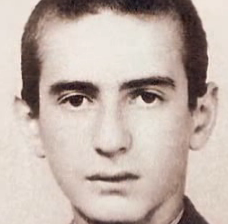 Not Wiesel at age 16 in 1945
Not Wiesel at age 16 in 1945
You can see for yourself from these two high-quality photographs supplied to me by a helpful reader that the face on the left is not Wiesel. On the right is Elie Wiesel in 1944 at the age of 15.
The inmate on the left definitely has an aquiline nose and full, even sensual, lips. In this close-up, the receding hairline is visible on the recently shaved head. On the right, the real 15-year-old Elie Wiesel exhibits a normal youthful hairline, a differently shaped nose and thinner lips. He also has a higher forehead than the more roundish-headed inmate. The eyes of the man on the left are not as deep-set under the eyebrows. His somewhat surprised, curious expression is not typical of Wiesel, whose expression was generally reserved, and often hooded.
The close-up on the left appears to be the real Elie Wiesel in France later in 1945. He would be 17 or almost 17 years old in this picture. Notice the non-receding, youthful hairline with a long front lock hanging to the side, and the slightly concave curve of the nose .
This close-up image is from the photograph below, which is found at the USHMM Survivor Resource Center with the caption given below.
Jewish boys gather for a prayer service in a chapel in an OSE children’s home. Those pictured include Elie Wiesel (seen in profile, back right) and Jakob Rybsztajn standing next to him facing the camera.
(I note that Elie Wiesel is older than the other boys in this picture, giving credence to the idea that he acted in the role of counselor and sometime teacher to the newer, younger “religious” boys.)
Notice again the slight concave curve of the nose, the high forehead, deep-set eyes, large ears, sensitive mouth and slender neck. But also look at all that hair! The date of this picture is given by USHMM as 1945 and the location as Ambloy, [Loir et Cher] France. It says in the accompanying text “In October 1945 the children and staff of Ambloy were relocated to the Chateau de Vaucelles in Taverny (Val d’Oise).” That means this picture was taken between June and October 1945. They could have been celebrating Rosh Hashana, Yom Kippur or Sukkot.
But could his hair have grown to such a length from a shaved head in April 1945? No way, and thus this is another proof that the liberated Buchenwald inmate with the shaved head is NOT Elie Wiesel.
A PDF from my valued contributer examines the ages of the small group more closely. Take a look:
Who first identified Elie Wiesel in the famous Buchenwald liberation photo?
In October 1983, the New York Times published this photograph as part of an article in its high circulation Sunday NYT Magazine with the caption: “On April 11, 1945, American troops liberated the concentration camp’s survivors, including Elie, who later identified himself as the man circled in the photo.”
Coincidentally, it was 1983 when Wiesel’s friend Sigmund Strochlitz began campaigning for a Nobel prize for Wiesel. Letters of nomination are due into the Nobel committee by Feb.1 of each year, so by January 1984, the committee was receiving letters nominating Wiesel from U.S. Senators such as Daniel Moynihan and Barry Goldwater. (see “How Elie Wiesel Got the Nobel Peace Prize“) The effort continued, with new and ever more innovative ideas, through 1985 and 1986 with the help of John Silber, President of Boston University, Wiesel’s employer. Hundreds were enlisted into the effort.
The 1983 article in the New York Times that was the opening gun of the campaign was written by Jew Samuel Freedman and titled “Bearing Witness: The Life and Work of Elie Wiesel.” It included this line: “His name has been frequently mentioned as a possible recipient of a Nobel Prize, for either peace or literature.” Well, it had just begun to be mentioned … by this team of cheerleaders.
Wiesel pretends that he had nothing to do with it. In an interview in France in 2009, he said: “If you fight or if you do scientific research to get the Nobel, you never succeed and you should not succeed.” (Elie Wiesel, “messager de la memoire”) No, he did not fight but his mercenaries fought for him, and he used this photograph as his “research.” That this photograph played a large role is shown by the fact that immediately after the Nobel award ceremony in December 1986, Wiesel went to Yad Vashem Memorial in Jerusalem and posed in front of its prominent display there.
Elie Wiesel on Dec. 18, 1986 at Yad Vashem in Jerusalem
After the award was announced by the Nobel Committee, the New York Times published again on Nov. 1 a severely cropped version of the Buchenwald photo (below) with the caption: “Elie Wiesel, the winner of the Nobel Peace Prize (at far right in the top bunk) in the Buchenwald concentration camp in April 1945, when the camp was liberated by American troops.” The picture accompanied an article by Jew Martin Susskind titled, “A Voice from Bonn: History Cannot Be Shrugged Off.”
The role played by the tax-payer funded United States Holocaust Memorial Museum
Elie Wiesel finagled his way to becoming Founding Chairman of the United States Holocaust Memorial Council in 1980 after being chosen in 1978 by President Jimmy Carter as chairman of the President’s Commission on the Holocaust. Why the United States needed to do anything at all about the “Holocaust” is something only the 2.5% Jewish population in this country can answer. It is to satisfy them. Wiesel continued to chair the Council until 1986, when he reached his goal of becoming a Nobel Laureate. The USHMM was undoubtedly an important institutional heavyweight that leveraged him to the Nobel.
The USHMM naturally accepted that Wiesel was in the famous photograph as soon as he and the New York Times said he was. If you think the museum staff does real research, is searching for truth and/or is engaged in scholarship of any kind, you are badly mistaken. The museum represents official power only and is invested in keeping it in Jewish hands.
This photograph is the only document tying Elie Wiesel to the Holocaust
The only document that connects Elie Wiesel to the Auschwitz-Birkenau and Buchenwald experience he claims to have—in other words, his claim to be an authentic “Holocaust survivor”—is the famous Buchenwald liberation photograph. There are no records with his name and birth date for either camp. His books do not support his presence there very well. That’s why the Wiesel promoters, who wanted to anchor their man’s claim to be the unchallenged spokesman for the world’s greatest victims—which winning a Nobel prize would surely do—decided that they could pawn that unknown face off as the face of Wiesel. This decision was made in 1983. It’s certain that Elie Wiesel took part in making it, though the pretense is kept up by all that he was aloof from the entire process.
What you must do
When you comprehend the immense power that this simple photo comparison and commentary gives us, you know that we have it in our hands to break down the Wiesel legend if this knowledge is widely circulated. If you understand this, you know what you must do. You must post this article everywhere you can, you must tell everyone about it, send it to all you know … make sure that this photo comparison moves through the Internet and finds a home in as many places as possible. And keep it up, because once is not enough. I’ve done my part, readers. Now it’s up to you.
Gigantic Fraud Carried Out for Wiesel Nobel Prize
By Carolyn Yeager
Proof that the man in the famous Buchenwald photograph is NOT Elie Wiesel.
With the help of the New York Times and the U.S. Holocaust Memorial Museum, Elie Wiesel and his backers did not shy away from criminal deceit by purposely misidentifying an unknown face in this famous photo as belonging to Elie Wiesel.
The above high-resolution photograph of Buchenwald survivors was first published in the New York Times on May 6, 1945 with the caption “Crowded Bunks in the Prison Camp at Buchenwald”. [click on image twice to enlarge fully] It was taken inside Block #56 by Private H. Miller of the Civil Affairs Branch of the U.S. Army Signal Corps on April 16, 1945, five days after the Buchenwald camp was liberated by a division of the US Third Army on April 11, 1945. None of the men in the picture were identified at that time.
The U.S. Army photographer was in block #56, not #66
The U.S. Army photographer said he was inside Block #56. The “children’s block” that housed the so-called “boys of Buchenwald” was #66. This was not a typo. Note that these men are not children or teenagers, except for the youngster on the lower left who has been correctly identified as 16 yr. old Myklos (Nikolaus) Grüner, and maybe a couple others. These adults appear to be a mixture of sick individuals suffering from a wasting disease (Grüner learned after liberation he had TB), along with basically healthy men who were also in that block, for some unknown reason, five days after they had been freed. As we have read from many Buchenwald inmates, they moved about at will from the day of liberation onward. In Elie Wiesel’s book Night, he even says that some of the boys in his block went to the city of Weimar the very next day to steal potatoes and rape girls.
The true facts of this photograph have never been told and perhaps are not known. (Grüner has written in Stolen Identity that he left a procession of youths being led to the camp entrance on the morning of April 11, scurried into the nearest barracks and jumped into an empty bunk space. It turned out to be this one.) But because of the man standing there stark naked except for a piece of clothing held in his hands to cover himself, this photograph was certainly staged. In any event, it was never represented as the “children’s barracks.” Still, Elie Wiesel inexplicably once told an interviewer for the German weekly Die Zeit that this photograph was taken in the Children’s Block and all these men were really teenagers even though they looked old. (Source: “1945 und Heute: Holocaust,” Die Zeit, April 21, 1995.)
Kenneth Waltzer wrote to this website EWCTW on Nov. 14, 2010: “Eli Wiesel was indeed the Lazar Wiesel who was admitted to Buchenwald on January 26, 1945, who was subsequently shifted to block 66…” and Waltzer repeated in another comment on June 27, 2011 that “— after his father died — Elie Wiesel was moved in early February to block 66, the kinderblock. Miklos Gruner too was in block 66. Elie Wiesel was there with other boys from Sighet, who knew him.”
But we are also to accept that on April 16 Wiesel was in block 56, even though he didn’t report any such move in his book Night. In fact, in that fictitious story, Wiesel says he became deathly ill with food poisoning three days after liberation (April 14) and spent the next two weeks in hospital (pg 115, Marion Wiesel translation). That in itself precludes his being in this photograph taken on April 16!
Whom do you believe—the New York Times or your own eyes?
 Not Wiesel at age 16 in 1945
Not Wiesel at age 16 in 1945
You can see for yourself from these two high-quality photographs supplied to me by a helpful reader that the face on the left is not Wiesel. A close inspection of the prisoners in the bunks in the famous photograph reveals that the eyebrows on many (including the one on the left above) were emphasized with a dark crayon/pencil … in other words, retouched or “photo-shopped.” On the right is what is claimed to be Elie Wiesel in 1944 at the age of 15.
The inmate on the left definitely has an aquiline nose and full, even sensual, lips. In this close-up, the receding hairline is visible on the recently shaved head. On the right, the real 15-year-old Elie Wiesel exhibits a normal youthful hairline, a bigger and longer nose and thinner lips. He also has a higher forehead and longer face than the more roundish-headed inmate. The eyes of the man on the left are not as deep-set under the eyebrows. His somewhat surprised, curious expression is not typical of Wiesel, whose expression was generally reserved, and often hooded.
The close-up on the left appears to be the real Elie Wiesel in France later in 1945. He would be 17 or almost 17 years old in this picture. Notice the non-receding, youthful hairline with a very long front lock hanging to the side, and the straight nose .
This close-up image is from the photograph below, which is found at the USHMM Survivor Resource Center with the caption given below. (click here or on lower pic for an undistorted, larger image)
Above, Jewish boys gather for a prayer service in a chapel in an OSE children’s home in 1945. Those pictured include Elie Wiesel (seen in profile) and Jakob Rybsztajn standing next to him facing the camera. (I note that Elie Wiesel is older than the other boys in this picture, giving support to the idea that he acted in the role of counselor and sometime teacher to the newer, younger religious boys.)
Notice again the straight nose, the high forehead, deep-set eyes, large ears, sensitive mouth and slender neck. But also look at all that hair! The date of this picture is given by USHMM as 1945 and the location as Ambloy, [Loir et Cher] France. It says in the accompanying text “In October 1945 the children and staff of Ambloy were relocated to the Chateau de Vaucelles in Taverny (Val d’Oise).” That means this picture was taken between June and October 1945. They could have been celebrating Rosh Hashana, Yom Kippur or Sukkot.
But could his hair have grown to such a length from a shaved head in April 1945? No way, and thus we have another proof that the liberated Buchenwald inmate with the shaved head is NOT Elie Wiesel.
A PDF from my valued contributer examines the ages of the small group more closely. In my opinion, he has the ages of all four men a little too young but especially #2 and 4. Take a look: four men in bunk
Who first identified Elie Wiesel in the famous Buchenwald liberation photo?
In October 1983 the Jewish-owned New York Times published this photograph as part of an article in its high circulation Sunday NYT Magazine with the caption: “On April 11, 1945, American troops liberated the concentration camp’s survivors, including Elie, who later identified himself as the man circled in the photo.”
It was also in 1983 that Wiesel’s friend Sigmund Strochlitz began campaigning for a Nobel prize for Wiesel. Letters of nomination are due into the Nobel committee by Feb.1 of each year, so by January 1984, the committee was receiving letters nominating Wiesel from U.S. Senators such as Daniel Moynihan and Barry Goldwater (both Jewish). [see “How Elie Wiesel Got the Nobel Peace Prize“] The effort continued, with new and ever more innovative ideas, through 1985 and 1986 with the help of Jew John Silber, President of Boston University, Wiesel’s employer. Hundreds were enlisted into the effort.
The 1983 article in the New York Times that was the opening gun of the campaign was written by Jew Samuel Freedman and titled “Bearing Witness: The Life and Work of Elie Wiesel.” It included this line: “His name has been frequently mentioned as a possible recipient of a Nobel Prize, for either peace or literature.” Well, it had just begun to be mentioned … by this team of cheerleaders.
Wiesel pretends that he had nothing to do with it. In an interview in France in 2009, he said: “If you fight or if you do scientific research to get the Nobel, you never succeed and you should not succeed.” (Elie Wiesel, “messager de la memoire”) No, he did not fight but his mercenaries fought for him, and he used this photograph as his “research.” That this photograph played a large role is shown by the fact that immediately after the Nobel award ceremony in December 1986, Wiesel went to Yad Vashem Memorial in Jerusalem and posed in front of its prominent display there.
After the award was announced by the Nobel Committee, the New York Times published on Nov. 1 a severely cropped version of the Buchenwald photo (below) with the caption: “Elie Wiesel, the winner of the Nobel Peace Prize (at far right in the top bunk) in the Buchenwald concentration camp in April 1945, when the camp was liberated by American troops.” The picture accompanied an article by Jew Martin Susskind titled, “A Voice from Bonn: History Cannot Be Shrugged Off.”
The role played by the tax-payer funded United States Holocaust Memorial Museum
Elie Wiesel finagled his way to becoming Founding Chairman of the United States Holocaust Memorial Council in 1980 after being chosen in 1978 by President Jimmy Carter as chairman of the President’s Commission on the Holocaust. Why the United States needed to do anything at all about the “Holocaust” is something only the 2.5% Jewish population in this country can answer. It is to satisfy them. Wiesel continued to chair the Council until 1986, when he reached his goal of becoming a Nobel Laureate. The USHMM was undoubtedly an important institutional heavyweight that leveraged him to the Nobel.
The USHMM naturally accepted that Wiesel was in the famous photograph as soon as he and the New York Times said he was. If you think the museum staff does real research, is searching for truth and/or is engaged in scholarship of any kind, you are badly mistaken. The museum represents official power only and is invested in keeping it in Jewish hands.
This photograph is the only document tying Elie Wiesel to the Holocaust
The only document that connects Elie Wiesel to the Auschwitz-Birkenau and Buchenwald experience he claims to have—in other words, his claim to be an authentic “Holocaust survivor”—is the famous Buchenwald liberation photograph. There are no records with his name and birth date for either camp. His books do not support his presence there very well. That’s why the Wiesel promoters, who wanted to anchor their man’s claim to be the unchallenged spokesman for the world’s greatest victims—which winning a Nobel prize would surely do—decided that they could pawn that unknown face off as the face of Wiesel. This decision was made in 1983. It’s certain that Elie Wiesel took part in making it, though the pretense is kept up by all that he was aloof from the entire process.
What you must do
When you comprehend the immense power that this simple photo comparison and commentary gives us, you know that we have it in our hands to break down the Wiesel legend if this knowledge is widely circulated. If you understand this, you know what you must do. You must post this article everywhere you can, you must tell everyone about it, send it to all you know … make sure that this photo comparison moves through the Internet and finds a home in as many places as possible. And keep it up, because once is not enough. I’ve done my part, readers. Now it’s up to you.
Source: https://www.eliewieseltattoo.com/?s=Miklos+Gruner


